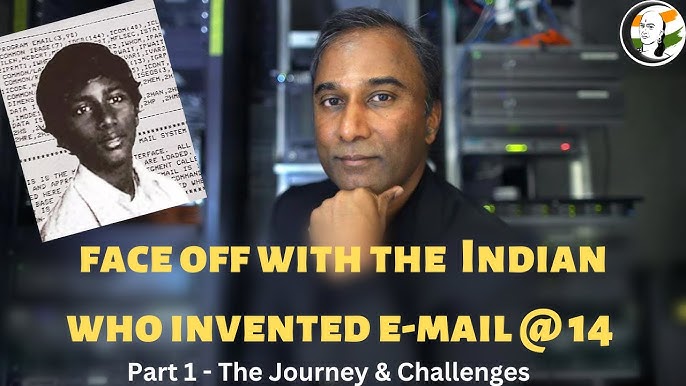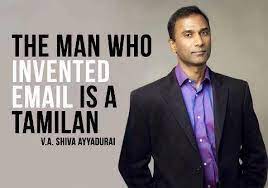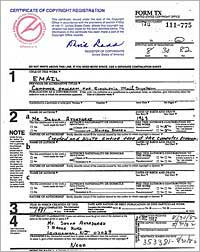
Dr. Ayyadurai: Indian-American Inventor of the Initial Email System
Email is a remarkable technical testament to human ingenuity and aptitude. The main character of the novel is Dr Shiva Ayyadurai, a distinguished person whose contributions to the field of digital technology have been genuinely remarkable.
Recently, Dr. Ayyadurai has shown interest in running for president of the United States (US).
With an emphasis on Dr. Ayyadurai’s crucial role in creating a technology that is now a necessary part of our daily lives, this essay seeks to explore the fascinating history of email.

Dr Shiva Ayyadurai
An Indian-American inventor, Dr Ayyadurai developed the initial email system as a precocious young talent in 1978.
Having been born in India and subsequently relocating to the US, he cultivated his enthusiasm for technology, obtaining four degrees from the Massachussetts Institute of Technology (MIT), including a Doctor of Philosophy (PhD).
His rise from a youthful genius to a known technologist is distinguished by his pioneering work in electronic communication.
Dr Ayyadurai’s career encompasses technology, entrepreneurship, biological research, and political engagement, demonstrating his broad competence and contributions.
A computer software created by 14-year-old V.A. Shiva Ayyadurai in 1978 mimicked the functions of the interoffice, interorganisational paper mail system. His program was called “EMAIL.” The United States Copyright Office granted Shiva a Certificate of Registration, No. TXu-111-775, for his software in 1982 after he submitted an application for copyright.
 |
| First US Copyright for “EMAIL, Computer Program for Electronic Mail System” issued to V.A. Shiva Ayyadurai. |
He deposited parts of the original source code with the program as required by the Copyright Office’s Regulations. The name he gave the software, “EMAIL,” stands out in the code. For the “EMAIL User’s Manual” he wrote to go with the software and that instructed novice users on how to utilise EMAIL’s capabilities, he was granted a second Certificate of Registration, No. TXu-108-715.
However, the question of who created email has recently become the subject of intense debate. Shiva has unfortunately been the target of several attacks as a result of this debate. The fact that various people use the phrase to indicate somewhat different things contributes to the issue.
The Man Who Invented Email™
|
In the summer of 1978, Shiva had been recruited for programming assignments at the University of Medicine and Dentistry of New Jersey (UMDNJ) in Newark, New Jersey. One of his supervisors, Dr. Leslie P. Michelson, recognized his abilities and challenged him to translate the conventional paper-based interoffice and inter-organizational communication system (i.e., paper-based mail and memoranda) to an electronic communication system. Systems for communications among widely dispersed computers were in existence at the time, but they were primitive and their usage was largely confined to computer scientists and specialists. |
|
Shiva had a simpler idea—one that would enable everyone—from the CEO to the secretary—to send and receive digital communications with speed and dependability. Shiva accepted the job and started by conducting a comprehensive analysis of UMDNJ’s paper-based mail system, which is the same as that utilised by offices and organisations globally.
|
He determined that the essential features of these systems included functions corresponding to “Inbox”, “Outbox”, “Drafts”, “Memo” (“To:”, “From:”, “Date:”, “Subject:”, “Body:”, “Cc:”, “Bcc:”), “Attachments”, “Folders”, “Compose”, “Forward”, “Reply”, “Address Book”, “Groups”, “Return Receipt”, “Sorting”. These capabilities were all to be provided in a software program having a sufficiently simple interface that needed no expertise in computer systems to use efficiently to “Send” and “Receive” mail electronically. It is these features that make his program “email” and that distinguish “email” from prior electronic communications. Shiva went on to be recognized by the Westinghouse Science Talent Search Honors Group for his invention. |
His creation was one of four in the 1,040 new freshmen cohort at the Massachusetts Institute of Technology. The Smithsonian Institution accepted his papers that documented the creation of email. There is no denying that these truths are supported by institutional, governmental, and legal acknowledgement and evidence.
Misconceptions About Email
However, conventional histories of the Internet are replete with assertions that specific people (and groups) in the ARPAnet environment and other big corporations in the 1970s and 1980s “invented email.”
|
For example, the familiar “@” sign, early programs for sending and receiving messages, and technical specifications known as RFCs, are examples of such false claims to “email”. But as some claimants have admitted, even as late as December 1977, none of these innovations were intended to emulate the paper-based mail system – Inbox, Memo, Outbox, Folders, Address Book, etc. Sending text messages electronically could be said to date back to the Morse code telegraph of the mid 1800s; or the 1939 World’s Fair where IBM sent a message of congratulations from San Francisco to New York on an IBM radio-type, calling it a “high-speed substitute for mail service in the world of tomorrow.” |
Primitive electronic communication systems employed the initial text message, ARPANET messaging, electronic content or picture transfers, and even the “@” symbol. These early computer programs were obviously not email, even if the tech pioneers who developed these systems deserve praise for their efforts and recognition for their particular achievements and contributions.
The Unfortunate Reaction to the Invention of Email
|
Based on false claims, over the past year (since the acceptance of Shiva’s documents into the Smithsonian), industry insiders have chosen to launch an irrational denial of the invention. There is no direct dispute of the invention Copyright, but rather inaccurate claims, false statements, and personal attacks waged against Shiva. Attackers are attempting to discredit him, and his life’s work. He has received threatening phone calls, unfair online comments, and his name and work has been maligned. It is but a sad commentary that a vocal minority have elected to hijack his accomplishment, apparently not satisfied with the recognition they have already received for their contributions to the field of text messaging. Following the Smithsonian news, they went into action. They began historical revisionism on their own “History of Electronic Mail” to hide the facts. |
In order to give credit to their own work done before 1978, they hired “historians” who began debating how to redefine the term “email.” More obviously, they awarded a new award to one of their own as the “inventor of email” and registered the InternetHallofFame.Org website seven (7) days after the Smithsonian revelation. The multibillion dollar corporation BBN used its public relations apparatus to declare itself the “godfather of email” and the “king of email.” These steps were done to defend their deceptive branding and lessen the praise and fair acknowledgement Shiva was starting to get. Shiva’s announcement probably puts BBN’s whole brand at risk, since the company has purposefully contrasted “innovation” with the “@” emblem and the image of its mascot, the self-described “inventor of email.”. They have removed damaging references to eminent Internet pioneers of the time such as MA Padlipsky who exposed their lies, and showed that BBN’s mascot, was not the “inventor of email”.
Despite the overwhelming evidence, some business insiders have even gone so far as to try to mislead the public by claiming that “EMAIL” is not the same as “email.” Prior to 1978, the term “email”—which juxtaposes the five letters “e,” “m,” “a,” “i,” and “l”—did not exist. Because UMDNJ followed the upper-case naming standard for software programs, subroutines, and variables created in FORTRAN IV, the software program EMAIL was named entirely in capital letters. Additionally, the usage of capital letters for program, subroutine, and variable names at that time was a holdover from the punch card era of software program authoring.
The fact is EMAIL is email, upper case, lower case, any case.
A Time for Reflection
Unfortunately, some of these people have gone so far as to claim that unfounded accusations are not enough to support their position. They have resorted to the most heinous forms of character assassination, such as deleting and destroying information from Wikipedia in order to discredit Shiva as an inventor of any type. It is unbelievable that he received racist and threatening emails telling him “to hang himself by his dhothi,” blogs calling him a “flagrant fraud,” and remarks that EMAIL was “not an invention.” These remarks reveal a narrow-minded belief that innovation can only occur in big businesses, universities, and the military.
As MIT’s Institute Professor Noam Chomsky reflected: “The efforts to belittle the innovation of a 14-year-old child should lead to reflection on the larger story of how power is gained, maintained, and expanded, and the need to encourage, not undermine, the capacities for creative inquiry that are widely shared and could flourish, if recognized and given the support they deserve.“
Of course a claim such as “I invented email” will leave anyone open to criticism and doubt, and as some suggest “hatred”. In this case, the victim has not made a “claim”, but rather been recognized by the government and top educational institutions in the world as an inventor. Regardless of the vitriol, animosity and bigotry by a vocal minority, a simple truth stands: email was invented by a 14-year-old working in Newark, NJ in 1978. This is a fact. Innovation can occur, any place, any time, by anybody.
The Legacy Of Email
Dr Ayyadurai’s email system laid the groundwork for future developments in digital communication:
Standardising email communication: While he did not invent electronic messaging, his work in creating a comprehensive system that incorporated all aspects of the interoffice mail system was crucial in standardising email communication.
Influencing modern email systems: The principles and functionalities he introduced are echoed in modern email systems, underscoring his influence on the evolution of digital communication.
In conclusion, Dr Ayyadurai’s contribution to the invention of email demonstrates a combination of technical expertise and forward-thinking vision.
His early involvement with the email system showcased not just his programming proficiency, but also a profound comprehension of human communication and the potential of technology to augment this process.
His efforts extended beyond programming a software; they had a crucial role in influencing our perspectives and interactions with digital communication tools, solidifying his status as a pioneering developer in the era of digital technology.







